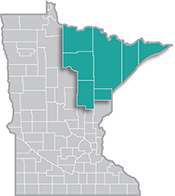 Home to the state's second-largest metro, the Northeast Region has a strong industrial sector, tied largely to the area's abundant natural resources.
Home to the state's second-largest metro, the Northeast Region has a strong industrial sector, tied largely to the area's abundant natural resources.
Most of the manufacturing base centers on mining and forest products industries. More than half of the sector's employment is in paper and machinery manufacturing.
Want the freshest data delivered by email? Subscribe to our regional newsletters.
3/31/2021 9:00:00 AM
Carson Gorecki
The coronavirus pandemic is changing the way we work. One trend that has received considerable attention is the ascension of remote work or telework. As my colleague Cameron Macht points out in his recent article in Minnesota Economic Trends, the rate of teleworking in Minnesota increased considerably with the onset of the pandemic – rising from about 7% pre-pandemic to as high as 35.4% of the labor force last May. Since that high point, the share of the labor force working from home has leveled out but has remained more than triple the pre-pandemic rate as of January 2021. It is likely that even after the public health threat recedes, many workers would opt to continue to work remotely, if their employers let them.
The likely long-term increase in telework presents opportunities for rural areas looking to attract people. A related trend that has also captured attention is that of "Zoom Towns". Unshackled from the requirement to live near an office, workers are choosing to re-locate from cities to more rural places with access to different amenities, outdoor activities, and more space. However, not all workers have the same opportunity to take advantage of this new-found flexibility. As the Bureau of Labor Statistics shows, higher-paying occupations that tend to require higher average levels of educational attainment such as Computer & Mathematical, Legal, Business & Financial Operations, and Architecture and Engineering occupations are most likely to have the option to work remotely. This trend aligns with the social distancing rankings I highlighted in a blog last year.
Some of the jobs that are most easily conducted remotely are in the technology and information fields. One way to grow the relatively small tech workforce in Northeast Minnesota is to retain the talent that is developed in our own figurative backyards. The College of St. Scholastica, University of Minnesota-Duluth, and Lake Superior College all offer Computer and/or Mathematics programs. Combined, these programs graduated nearly 200 students in the 2016-2017 academic year, according to data from DEED's Graduate Employment Outcomes (GEO) tool (see Table 1). However, of these potential tech workers, less than two out of every five stayed to work in Northeast Minnesota. The likelihood that a graduate of a Computer or Math program found employment in the region decreased by educational attainment.
| Program | Number of Graduates | Percent of Graduates Employed in Northeast Minnesota 3 Years After Graduation | |||
|---|---|---|---|---|---|
| All Graduates | Graduates with Associate Degrees | Graduates with Bachelor's Degrees | Graduates with Graduate Degrees | ||
| Computer or Mathematics | 198 | 37.3% | 68.3% | 30.8% | 20.3% |
| All Programs | 4,586 | 38.5% | 67.8% | 36.3% | 52.9% |
| Source: MN DEED Graduate Employment Outcomes | |||||
Those with associate degrees were more than twice as likely as those with bachelor's degrees and more than three times as likely than those that obtained graduate degrees to be employed in the region. Computer and Mathematics graduates stay in Northeast Minnesota at similar rates to graduates from all programs, with the exception of those earning graduate degrees, which are less than half as likely to become employed in the region. The most popular destination of Computer and Mathematics graduates is perhaps no surprise. The Twin Cities has a much higher concentration of jobs in Computer and Mathematical occupations, 4.6% of all jobs compared to 1.3% in Northeast Minnesota (DEED Occupational Employment Statistics).
One more potential approach to grow tech jobs is to try and recruit the businesses themselves. With fewer physical requirements tying tech companies to a particular place, the same quality of life factors and amenities that are attracting individual workers might also appeal to an organization. In addition, efforts to leverage the equalizing effects of broadband can be seen in the creation of rural tech hubs. Aligning the existing pipeline of available tech workers from local institutions would be a key component of both strategies. For now, the tech graduates are there, but local opportunities need to be increased or broadened to convince more of these workers that starting their careers in Northeast Minnesota is a viable alternative to larger metropolitan areas. Rural areas can benefit from the changing landscape of work foisted upon us by the pandemic. The increase in remote work presents one intriguing new opportunity to attract or retain workers in Northeast Minnesota.
Visit DEED's Office of Broadband Development page for more information on initiatives and funding to expand broadband access in Minnesota
If you would like to learn more about DEED's efforts to foster entrepreneurship in Minnesota, check out our Launch Minnesota program.
April 2021 is Tech Month in Minnesota. Learn more at CareerForceMN.com/TechMonth.
Contact Northeast Minnesota Labor Market Analyst Carson Gorecki at 218-302-8413.